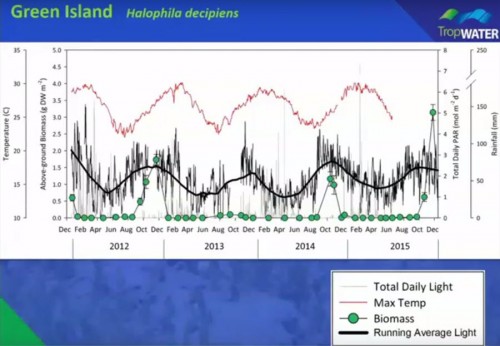Under pressure: Managing deep-water seagrasses of the Great Barrier Reef
Katie Chartrand (TropWater)
This talk covers:
- Segrass Ecology Group (1:05)
- The Great Barrier Reef: Its' not just coral (4:40)
- One of the world's largest seagrass ecosystems
- 20% of world's seagrass species
- Inter-reef, reef platform, nearshore
- Intertidal, subtidal
- Stable, ephemeral, seasonal
- Seagrass is important (5:36)
- Food for iconic species
- Connectivity
- Fisheries habitat
- Inter-reef habitat
- Sediment stabilization
- Primary production
- Management questions (6:01)
- Where does it grow?
- Where does it not grow?
- How much is there?
- What species is it?
- Does it vary spatially/temporally?
- What drives seagrass presence & productivity?
- GBR Deep-water Seagrasses - what we know: (6:55)
- In Queensland more than 31,000 km2 in GBR
- Meadow turnover: 1.7 - 4.1 days
- Dominated by Halophila species
- What we don't know: (8:30)
- Drivers of seasonality and change
- Species-specific information
- Tolerance levels
- How they re-establish after seasonal declines
- Aims of the Deep-water Seagrass Dynamics Project: (9:30)
- Investigate seasonal dynamics, drivers of changes, role of seed banks and recruitment and light thresholds.
- Undertaken at Lizard Island, Green Island and Keswick Island (Mackay)
- Experimental design (14:30)
- Shoot Density results (17:14)
- Below-ground carbohydrate reserves (18:19)
- Sex and seed banks (24:00)
- Germination Trials - Role of light (25:26)




